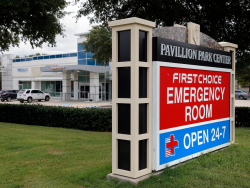Neighborhoods with ‘Medical Deserts’ Have Emergency Needs During COVID Pandemic
 A zip code has become a life or death matter. Families that live more than an hour from a hospital face a death sentence based on their address. A long ambulance ride increases the risk of death. Patients with respiratory emergencies, like the ones caused by coronavirus, are particularly vulnerable. According to an annual survey by the American Hospital Association, more than a thousand hospitals in the United States have closed since 1975. As a result, residents in communities from coast to coast must drive more than sixty minutes to reach an acute care hospital. These places are called “medical deserts,” and you can find them in every state.
A zip code has become a life or death matter. Families that live more than an hour from a hospital face a death sentence based on their address. A long ambulance ride increases the risk of death. Patients with respiratory emergencies, like the ones caused by coronavirus, are particularly vulnerable. According to an annual survey by the American Hospital Association, more than a thousand hospitals in the United States have closed since 1975. As a result, residents in communities from coast to coast must drive more than sixty minutes to reach an acute care hospital. These places are called “medical deserts,” and you can find them in every state.
If COVID-19 has taught us anything, it is that we desperately need new investment in our healthcare safety net and infrastructure. Indeed, a recent study by the COVID-19 Response Team at Imperial College London suggests that the “capacity limits of the UK and U.S. health system[s] [could be] exceeded many times over” during this crisis and warns that “even if all patients are able to be treated, we predict there would still be in the order of 250,000 deaths in Great Britain and 1.1 million to 1.2 million deaths in the U.S.”
As an emergency medicine physician and chair of the health committee of Black Women for Positive Change, I call on Congress and the administration to immediately implement the following recommendations in order to save lives, before it’s too late.
1. Congress should pass legislation to create free-standing FSEDs. FSEDs are 24-hour, seven-day-a-week emergency departments established in communities that lack emergency healthcare services and facilities. Standalone emergency departments are physically separate from hospitals; can be independently owned, hospital owned or, government owned; are staffed by emergency medicine physicians; and are available for walk-in patients and patients arriving by ambulance. These facilities treat and discharge patients while also transporting admitted cases to full-service hospitals by ambulance or helicopter. Even better, FSEDs can be built quickly, maintained at a fraction of the cost of large hospitals, and are just as effective at providing critical, time-sensitive medical care as hospital emergency departments. In other words, FSEDS can be a vital safety net for people who live in medical deserts.
2. Convert unused spaces into temporary COVID hospitals. As we are learning, healthcare facilities and providers can become vectors for the transmission of COVID-19. For that reason, it’s important to not only increase the number of critical beds with ventilator capability but also to physically separate COVID and non-COVID patients. To do that, we need to convert unused spaces into dedicated temporary COVID hospitals — and do it immediately. If we don’t, patients that are ill from non-COVID medical diseases are more likely to be infected by healthcare providers and other patients, thereby increasing overall morbidity and mortality rates. At the moment, every state in the U.S. has unused conference centers, coliseums, concert halls, and other large venues that can be converted into temporary COVID-only hospitals. Let’s get to it. Physically separating patients is a critical step in reducing mortality and morbidity rates.
3. Expand medical flight and ground transportation capacity. To strengthen our emergency and intensive care capacity, we need to move quickly to put more ambulances and medical flight helicopters into service. The physical fact of people living in medical deserts that lack the healthcare resources should not be a factor in whether they receive care for COVID-19. Because the coronavirus is straining transportation systems everywhere, we also need to develop Uber-like emergency services that help facilitate transportation to hospitals and emergency medical facilities.
“Dr. Crowder’s recommendations to address [the problem of] medical deserts in underserved communities is timely and urgent,” says Dr. Stephanie Myers, former assistant secretary for public affairs in the U.S. Department of Health and Human Services. “Her vision should be included in the new policies being considered by federal, state, and local governments. We must act fast to reduce the death rates associated with coronavirus. We are only at the beginning of this pandemic, but we have an opportunity, if we act quickly, to put in place the medical capacity Americans will need.”
Let us hope that Congress, governors, and the administration are listening.






